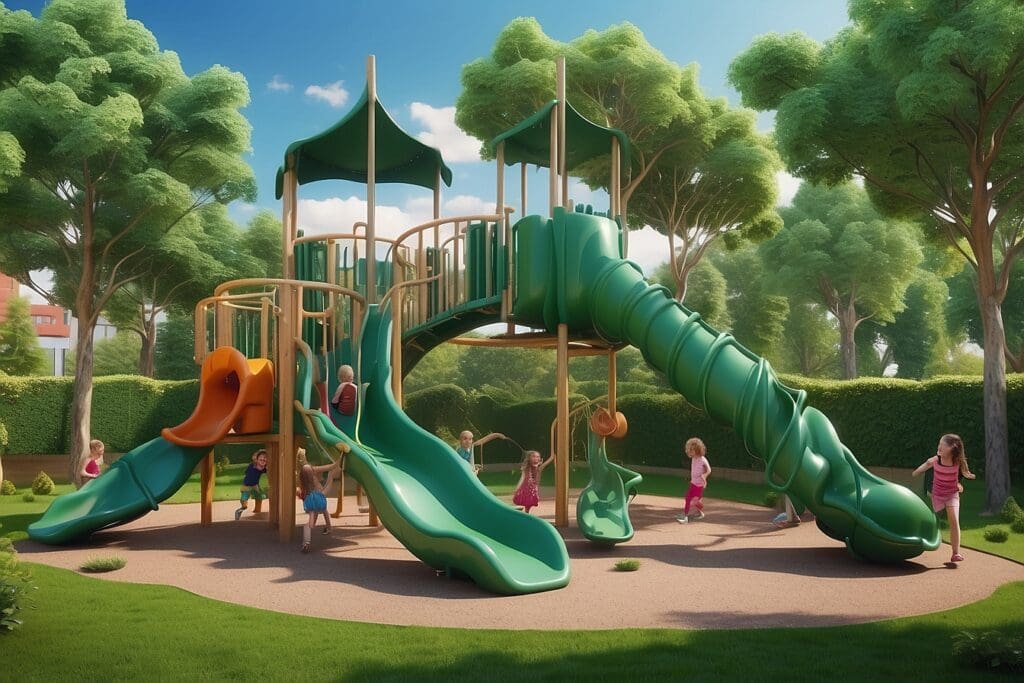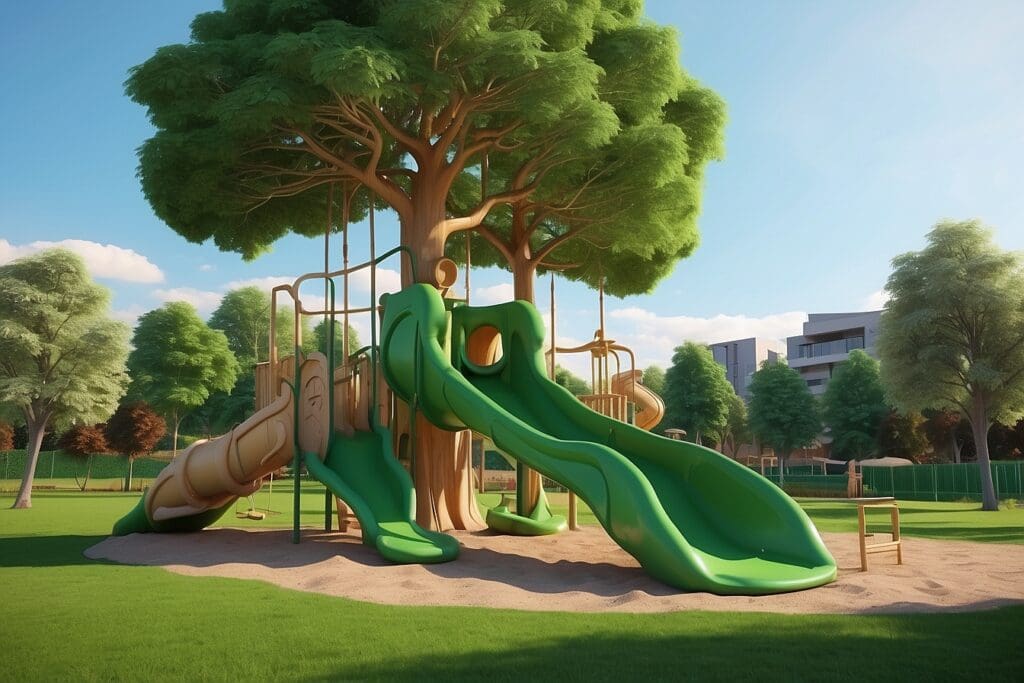We’d be walking down the street or through a park, holding our parent’s hand, and then we’d see it—the curve of a swing set, or the red, blues, and yellows of the monkey bars… and we set out running ☺ Playgrounds teach kids invaluable lessons—how to share, move, imagine, and have fun! Today, as children become more sedentary and their opportunities to explore the outdoors are more limited, playgrounds are more important than ever. Kids just want to play and parents just want their kids to stay safe, and that’s largely why environmentally friendly playgrounds are quickly gaining popularity. Generally, what’s safe for the environment is safe—and fun—for kids too.

The definition of a safe playground is changing. Some playground materials that were considered eco-friendly just years ago are now deemed dangerous. Most wooden playsets built prior to 2003 were specially treated with chromium copper arsenate (CCA), which preserves wood from weathering. Unfortunately, arsenate poses a health hazard to kids. According to a study by the Environmental Working Group, “one in 500 children who regularly come into contact with treated wood would be at risk for developing lung or bladder cancer later in life.”1 CCA is no longer used in the manufacture of new playsets, but it is still present in most playgrounds.
For years, crumb rubber was touted for its spongy texture that helps reduce playground accidents. Made of old tires, crumb rubber is a neat example of creative reuse. Even Sasha and Malia Obama play on crumb rubber on the White House playground!2 But crumb rubber might not be as safe as it seems. It contains about 30 toxic chemicals, including arsenic, cadmium, chromium, mercury, and several dangerous hydrocarbons.3 The Rubber Manufacturers Association says that there are more than 100 studies that vouch for the safety of tire crumb in playgrounds, but Jeff Ruch, head of Public Employees for Environmental Responsibility, says that only two of the toxins have been studied for possible toxicological effects in children.4
While most playgrounds still use the brightly-colored tire crumb, the good news is that some playset manufacturers are rethinking their materials. Companies like BigToys, Play Mart, and Game Time are manufacturing playsets made of recycled steel, plastics without PVC, and wood certified by the Forest Stewardship Council.5
In addition to changing playset materials, school officials and environmental planners are reconsidering playground designs. In the last decade, designs have changed, but not necessarily for the better. In an effort to increase safety, seesaws have disappeared, high bars have become lower, and long steel slides have been replaced with short plastic ones. Ironically, some say that these safety improvements have led to more playground accidents. Sharon Danks, an environmental planner, says, “My 4-year-old recently broke her arm on a play structure meant for 2 to 5-year-olds because she found it so boring. She was walking on the outside of the bridge and sliding down the handrail and fell off. These structures are so unchallenging that kids are making up their own activities, which are often 10 times more dangerous.”6
To remedy the problem, environmental planners like Danks are now creating playgrounds with less play structures and ball games and more ecological play areas, which combine diverse ecosystems for hands-on learning experiences. Asphalt is replaced with gardens, ponds, sand, and boulders. Natural playgrounds are springing up nationwide from Washington D.C., to Portland, and to Chicago. San Francisco’s playgrounds now boast “a 35-foot-long dry creek bed made of beautiful salvaged granite stones, climbing trees, fencing from recycled redwood chicken coops, native flowers, and a water pump for making mud pies and sand castles (muck boots included).”7
Danks says that ecological playgrounds also decrease bullying. She explains, “In more natural environments, it’s less about who’s the strongest and the fastest and more about using the imagination. It changes the dynamic of who’s in charge. And there’s less conflict because the kids aren’t as bored.”8 Critics of ecological playgrounds say that they don’t provide as much exercise as traditional playsets. Case in point: Carkeek Park in Seattle installed a conventional playset after parents complained that their kids were getting restless in the natural play spaces.9
Indeed, kids do expend a great deal of energy on see-saws, swings, ladders, and merry-go-rounds. So now engineers are thinking that all that kid-generated energy could go to good use! A school in Ghana is now using playground-playing power to light its school. When the children push their merry-go-round (which is partially made of recycled car parts), they make energy that lights their lamps!10 Who knew – producing clean energy is just child’s play ☺





